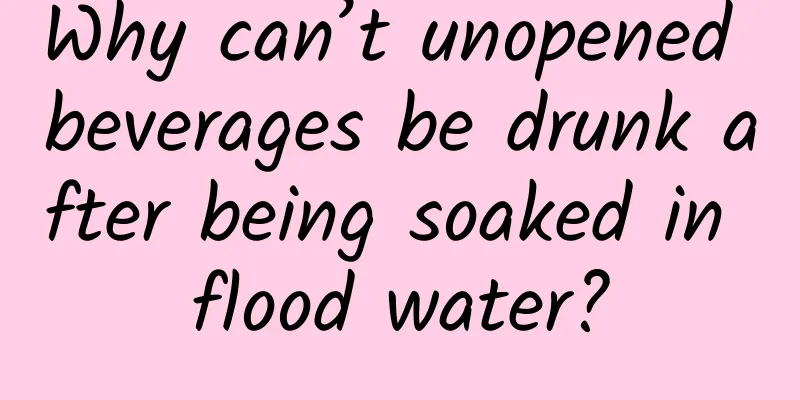Why can’t unopened beverages be drunk after being soaked in flood water?

|
Review expert: Wang Guoyi, Postdoctoral Fellow in Nutrition and Food Safety, China Agricultural University Affected by multiple typhoons, from late July to early August, Beijing-Tianjin-Hebei and the three northeastern provinces successively suffered rare heavy rainstorms and floods. While the rescue work was in full swing, some friends found that in the stores after the flood, there were boxes of bottled water that had not been opened, but had been soaked by the flood. Therefore, everyone was discussing whether the water, which had not been opened, could be used directly in the disaster area where supplies were scarce? But some people also said that even if the bottled water was not opened, it could not be drunk after being soaked in flood water. Why is that? Is the claim that bottled water soaked in flood water is unsafe an exaggeration or is there any basis for it? Source: Pexels 1Why can’t you drink unopened beverages? Many people don’t understand. Although the bottled water has been soaked in the flood, it is sealed. As long as it is not opened and the bottle cap and bottle are not damaged, and it is clean, why can’t it be drunk normally? First of all, I want to share with you a piece of “cold” knowledge: bottled water is not sealed. We need to use a lot of force to unscrew the bottle cap, and since there is no leakage when we turn the bottle upside down, we subconsciously think that bottled water is sealed, not knowing that the bottle cap only serves to tighten. Daily beverages are mainly packaged in PET plastic beverage bottles with a threaded mouth and a plastic screw cap. The design of this screw cap makes drinking water convenient and quick, and it can be opened with a little force, but the thread structure of the beverage bottle mouth only has a fastening effect, not a sealing effect, and the screw cap has no waterproof function, so it is not a waterproof container. When bottled water is in an immersed state, even with a threaded structure to reinforce it, the water outside containing pathogenic bacteria can contaminate the bottle mouth through "capillary phenomenon" and thus contaminate the entire bottle of water. We all know that objects are made up of molecules, and there is a mutual force between molecules. This force will produce capillary phenomena, that is, the phenomenon that liquid rises (or falls) along tiny gaps under wetting (or non-wetting) conditions. This "tiny gap" is formed between the bottle mouth and the bottle cap of bottled water. Because the threads are tightened, the gap is very thin and is less affected by air pressure, so it absorbs more water. Source: Pexels In an experiment involving bottled water immersed in contaminated liquid, researchers found that when the bottled water was directly inserted into a suspension of Pseudomonas aeruginosa and then sampled for testing, the detection rate of Pseudomonas aeruginosa was 40%. After opening the lid of a beverage soaked in flood water, stains were found inside. Source: Weibo picture @Chinanews.com Experiments have shown that when PET bottled beverages are sealed with bottle caps, there is no sealing measure between the bottle cap and the neck of the bottle. There is also a large gap between the bottle cap thread and the bottle mouth thread. In the wet state, bacteria can easily enter the bottle mouth thread. The humid and harsh storage environment is conducive to the reproduction of pathogenic bacteria, which continue to proliferate at the bottle thread and can move on the solid surface by extending and contracting their flagella. Therefore, the bacteria can break through the sealing effect at the top of the PET bottle mouth and cause contamination of the liquid in the bottle. During summer camping, people often like to soak various beverages in streams and rivers to "chill" them. This makes them taste better, but it also makes it easier to drink them wrong. If you really want to soak them in water, be careful not to cover the bottle cap. In the case of heavy rain and floods, water is more easily contaminated and may contain a large number of pathogenic bacteria. Bottled water soaked in floods must not be drunk or sold! Source: Pexels 2What diseases are likely to be caused by floods? Let's take a look at what diseases may be prevalent during floods. In the early stages of a flood, drinking water and food are easily contaminated or, through fecal-oral contact, can easily lead to intestinal infectious diseases such as bacterial dysentery and hand, foot and mouth disease, which are mainly manifested by digestive tract symptoms such as diarrhea, vomiting, fever, and abdominal pain. Severe cases may lead to dehydration, shock, and even death. In the middle stage of a flood, victims are transferred to embankments or high places, but living conditions are poor and overcrowded, the number of people sleeping outdoors increases, and the chances and frequency of military and civilians coming into contact with contaminated water during flood fighting and rescue operations, production and self-help efforts increase greatly. Certain respiratory infectious diseases become a major threat. In the later stage of the flood, when the flood waters receded, wild animals such as rats, snails and mosquitoes could easily reproduce in large numbers due to suitable climatic conditions, which increased the incidence of natural epidemic diseases, such as hemorrhagic fever, leptospirosis, epidemic encephalitis B, schistosomiasis, plague, etc. These infectious diseases are mainly spread through animals or insects, or through contact with animal carcasses or secretions. The main manifestations are severe systemic or local complications such as fever, bleeding, hepatosplenomegaly, and nervous system damage. Source: Pexels How do 3 people prevent and control diseases after a flood? A study investigated the hygiene of houses after floods, using walls, furniture and floors as test samples. The total number of Salmonella and Shigella dysenteriae (both infectious pathogens) detected was hundreds of times the safety standard. However, after environmental disinfection, the total number of bacteria can be reduced by more than 99%, and the number of pathogenic bacteria detected is almost zero, meeting the national safety standards. Therefore , after a flood, before returning home, the post-disaster environmental disinfection organized by the government is the first and most important step in epidemic prevention. So how should individuals in disaster areas protect themselves and avoid the occurrence of diseases? Source: Pexels If your hands, feet, or entire body is soaked in rain or flood water due to wading, be sure to wash them off with a hot shower after the disaster, but do not take a bath. Check if you have any wounds. If you have any wounds, even if they are small, you should clean them immediately (you can use saline solution, uncontaminated bottled water or boiled water), then disinfect and bandage them. If you cannot find the conditions, go to a medical institution to seek help as soon as possible. Do a good job of disinfecting the house. Don't feel bad about items and food that cannot be disinfected or have been soaked and contaminated. Be willing to throw them away when necessary. Health is the most important thing. Heavy rains and floods are merciless, but every time a flood occurs, the country and its soldiers bravely fight on the front line of disaster relief. As individuals, as long as we have a firm will, cooperate with the work, improve our awareness of protection, and produce self-help, we will surely usher in a sunny day. |
<<: The teacher is so cool! Looking back at the famous scenes of teaching in space
>>: One reason is enough to advise you to eat more apples!
Recommend
A high school student was sleepy, and a checkup revealed that he was suffering from severe depression! Which key groups are more likely to have psychological problems?
Recently, it was reported that a high school soph...
What did Pluto do wrong to be "expelled" from the solar system?
In the vast universe, the solar system is a uniqu...
Dingdong Maicai Product Analysis
The fresh food e-commerce industry is also an ind...
Getui officially releases "Smart Push", and push technology enters the 2.0 era
<p class="MsoNormal" align="left" style="text-a...
Speaking of the relationship between PHP's Memcache & Memcached extensions, do you understand it?
[51CTO.com original article] Memcached is a free,...
Can the 3-meter-long killer crab be eaten? Is it delicious?
recent Tadpole is getting ready because Crab seas...
“Never seen him in Beijing before”, who is this “mysterious guest”?
Audit expert: Wang Lei National Parks and Conserv...
SEO: How much does it cost to build a website?
Nowadays, there is a new form on the Internet alm...
Was there air pollution in ancient times? Let’s see what the ancients said!
Copywriter: Tianlan Editorial Office Edited by: R...
Content operation: 3 major driving forces of high-quality UGC!
There are three major driving forces for high-qua...
User operation, how to retain users after fission?
What I want to discuss with you this time is how ...
Why are earthquakes so frequent in Türkiye? Will they have an impact on areas along the Chinese earthquake belt?
The Turkish earthquake was not caused by the bend...
How much does it cost to develop a Tonghua hairdressing mini program? Tonghua Hairdressing Mini Program Development Price Inquiry
More and more businesses are paying attention to ...
Long awaited! Amap AR walking navigation is here: no need to worry about getting lost when walking
[[388494]] Today, Amap announced that the new ver...
Last night, a 4.8-magnitude earthquake occurred in Luding County, Ganzi Prefecture, Sichuan! Please save this guide to effective escape and self-rescue in case of an earthquake
The China Earthquake Networks Center officially d...









